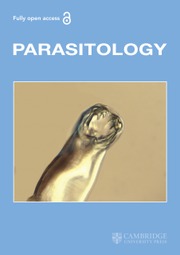Crossref Citations
This article has been cited by the following publications. This list is generated based on data provided by
Crossref.
Briand, Loïc
Swasdipan, Nicharat
Nespoulous, Claude
Bézirard, Valérie
Blon, Florence
Huet, Jean‐Claude
Ebert, Paul
and
Pernollet, Jean‐Claude
2002.
Characterization of a chemosensory protein (ASP3c) from honeybee (Apis mellifera L.) as a brood pheromone carrier.
European Journal of Biochemistry,
Vol. 269,
Issue. 18,
p.
4586.
Lorenzi, M. Cristina
Sledge, Matthew F.
Laiolo, Paola
Sturlini, Elena
and
Turillazzi, Stefano
2004.
Cuticular hydrocarbon dynamics in young adult Polistes dominulus (Hymenoptera: Vespidae) and the role of linear hydrocarbons in nestmate recognition systems.
Journal of Insect Physiology,
Vol. 50,
Issue. 10,
p.
935.
Herzner, Gudrun
Schmitt, Thomas
Linsenmair, K. Eduard
and
Strohm, Erhard
2005.
Prey recognition by females of the European beewolf and its potential for a sensory trap.
Animal Behaviour,
Vol. 70,
Issue. 6,
p.
1411.
Richard, F-J
Aubert, A
and
Grozinger, CM
2008.
Modulation of social interactions by immune stimulation in honey bee, Apis mellifera, workers.
BMC Biology,
Vol. 6,
Issue. 1,
Mazar, Amihai
Namdar, Dvory
Panitz-Cohen, Nava
Neumann, Ronny
and
Weiner, Steve
2008.
Iron Age beehives at Tel Reḥov in the Jordan valley.
Antiquity,
Vol. 82,
Issue. 317,
p.
629.
Flores-Prado, Luis
Aguilera-Olivares, Daniel
and
Niemeyer, Hermann M
2008.
Nest-mate recognition in
Manuelia postica
(Apidae: Xylocopinae): an eusocial trait is present in a solitary bee
.
Proceedings of the Royal Society B: Biological Sciences,
Vol. 275,
Issue. 1632,
p.
285.
Namdar, Dvory
Neumann, Ronny
Goren, Yuval
and
Weiner, Steve
2009.
The contents of unusual cone-shaped vessels (cornets) from the Chalcolithic of the southern Levant.
Journal of Archaeological Science,
Vol. 36,
Issue. 3,
p.
629.
Harbo, John R.
and
Harris, Jeffrey W.
2009.
Responses to Varroa by honey bees with different levels of Varroa Sensitive Hygiene.
Journal of Apicultural Research,
Vol. 48,
Issue. 3,
p.
156.
PICCOLO, F. DEL
NAZZI, F.
VEDOVA, G. DELLA
and
MILANI, N.
2010.
Selection of Apis mellifera workers by the parasitic mite Varroa destructor using host cuticular hydrocarbons.
Parasitology,
Vol. 137,
Issue. 6,
p.
967.
Harris, Jeffrey W
Danka, Robert G
and
Villa, José D
2010.
Honey Bees (Hymenoptera: Apidae) with the Trait of Varroa Sensitive Hygiene Remove Brood with All Reproductive Stages of Varroa Mites (Mesostigmata: Varroidae).
Annals of the Entomological Society of America,
Vol. 103,
Issue. 2,
p.
146.
Dussaubat, Claudia
Maisonnasse, Alban
Alaux, Cedric
Tchamitchan, Sylvie
Brunet, Jean-Luc
Plettner, Erika
Belzunces, Luc P.
and
Le Conte, Yves
2010.
Nosema spp. Infection Alters Pheromone Production in Honey Bees (Apis mellifera).
Journal of Chemical Ecology,
Vol. 36,
Issue. 5,
p.
522.
Alaux, C.
Maisonnasse, A.
and
Le Conte, Y.
2010.
Pheromones.
Vol. 83,
Issue. ,
p.
401.
Rosenkranz, Peter
Aumeier, Pia
and
Ziegelmann, Bettina
2010.
Biology and control of Varroa destructor.
Journal of Invertebrate Pathology,
Vol. 103,
Issue. ,
p.
S96.
Alaux, Cédric
Kemper, Nele
Kretzschmar, André
and
Le Conte, Yves
2012.
Brain, physiological and behavioral modulation induced by immune stimulation in honeybees (Apis mellifera): A potential mediator of social immunity?.
Brain, Behavior, and Immunity,
Vol. 26,
Issue. 7,
p.
1057.
Harris, Jeffrey W
Danka, Robert G
and
Villa, José D
2012.
Changes in Infestation, Cell Cap Condition, and Reproductive Status of Varroa destructor (Mesostigmata: Varroidae) in Brood Exposed to Honey Bees with Varroa Sensitive Hygiene.
Annals of the Entomological Society of America,
Vol. 105,
Issue. 3,
p.
512.
Baracchi, David
Fadda, Antonio
and
Turillazzi, Stefano
2012.
Evidence for antiseptic behaviour towards sick adult bees in honey bee colonies.
Journal of Insect Physiology,
Vol. 58,
Issue. 12,
p.
1589.
Annoscia, Desiderato
Del Piccolo, Fabio
and
Nazzi, Francesco
2012.
How does the mite Varroa destructor kill the honeybee Apis mellifera? Alteration of cuticular hydrcarbons and water loss in infested honeybees.
Journal of Insect Physiology,
Vol. 58,
Issue. 12,
p.
1548.
Strachecka, Aneta
Borsuk, Grzegorz
Olszewski, Krzysztof
Paleolog, Jerzy
and
Lipiński, Zbigniew
2013.
Proteolysis on the body surface of pyrethroid-sensitive and resistant Varroa destructor.
Acta Parasitologica,
Vol. 58,
Issue. 1,
Baracchi, David
Turillazzi, Stefano
and
Felicioli, Antonio
2014.
Patologia e avversità dell’alveare.
p.
27.
Chakroborty, Neloy Kumar
Bienefeld, Kaspar
and
Menzel, Randolf
2015.
Odor learning and odor discrimination of bees selected for enhanced hygienic behavior.
Apidologie,
Vol. 46,
Issue. 4,
p.
499.


